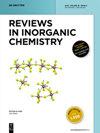Solid-phase extraction of organophosphates from polluted waters on a matrix-imprinted sorbent
IF 3.1
3区 化学
Q1 CHEMISTRY, INORGANIC & NUCLEAR
引用次数: 0
Abstract
The study aims to synthesize a selective matrix imprinted sorbent for the extraction of parathion and malathion. The structural unit of the polymeric framework was 2-methylpropanoic acid, the intermolecular crosslinker was ethylene glycol dimethacrylate, the polymerization initiator was azobisisobutyronitrile, the porogen was xylene, and the analyte was parathion. The synthesis was carried out under conditions of heating the reaction mixture to 65 °C, after which the matrix was washed with methanol to remove the analyte. For comparison purposes, non-imprinted control polymer was used as a negative control, which was prepared similarly, but without the addition of the analyte. The identification and quantification of organophosphates were performed by gas chromatography, and the morphological characteristics of the sorbents were evaluated by scanning electron microscopy. The optimal buffer for the purification of organophosphates was acetate buffer with a pH of 4; the optimal organic eluent was methanol. The limit of detection for para- and malathion was 0.1 μg/ml; the limit of quantification was 0.3 μg/ml. Linearity in the extraction conditions was observed in the range of 0.1–1 μg/ml for parathion and 0.1–2 μg/ml for malathion. The developed method will enable quick, selective, and cost-effective extraction of organophosphates from various substrates.用基质压印吸附剂固相萃取污染水体中的有机磷酸酯
本研究旨在合成一种用于萃取对硫磷和马拉硫磷的选择性基质印迹吸附剂。聚合物框架的结构单元为 2-甲基丙酸,分子间交联剂为乙二醇二甲基丙烯酸酯,聚合引发剂为偶氮二异丁腈,致孔剂为二甲苯,分析物为对硫磷。合成是在将反应混合物加热到 65 °C 的条件下进行的,然后用甲醇清洗基质以去除分析物。为便于比较,还使用了非压印对照聚合物作为阴性对照,其制备方法类似,但不添加分析物。有机磷的鉴定和定量采用气相色谱法,吸附剂的形态特征采用扫描电子显微镜进行评估。纯化有机磷的最佳缓冲液是 pH 值为 4 的醋酸盐缓冲液;最佳有机洗脱液是甲醇。对硫磷和马拉硫磷的检测限为 0.1 μg/ml,定量限为 0.3 μg/ml。在萃取条件下,对硫磷的线性范围为 0.1-1 μg/ml,马拉硫磷的线性范围为 0.1-2 μg/ml。所开发的方法可以快速、选择性和经济地从各种底物中提取有机磷。
本文章由计算机程序翻译,如有差异,请以英文原文为准。
求助全文
约1分钟内获得全文
求助全文
来源期刊

Reviews in Inorganic Chemistry
化学-分析化学
CiteScore
7.30
自引率
4.90%
发文量
20
审稿时长
1 months
期刊介绍:
Reviews in Inorganic Chemistry (REVIC) is a quarterly, peer-reviewed journal that focuses on developments in inorganic chemistry. Technical reviews offer detailed synthesis protocols, reviews of methodology and descriptions of apparatus. Topics are treated from a synthetic, theoretical, or analytical perspective. The editors and the publisher are committed to high quality standards and rapid handling of the review and publication process. The journal publishes all aspects of solid-state, molecular and surface chemistry. Topics may be treated from a synthetic, theoretical, or analytical perspective. The editors and the publisher are commited to high quality standards and rapid handling of the review and publication process.
Topics:
-Main group chemistry-
Transition metal chemistry-
Coordination chemistry-
Organometallic chemistry-
Catalysis-
Bioinorganic chemistry-
Supramolecular chemistry-
Ionic liquids
 求助内容:
求助内容: 应助结果提醒方式:
应助结果提醒方式:


